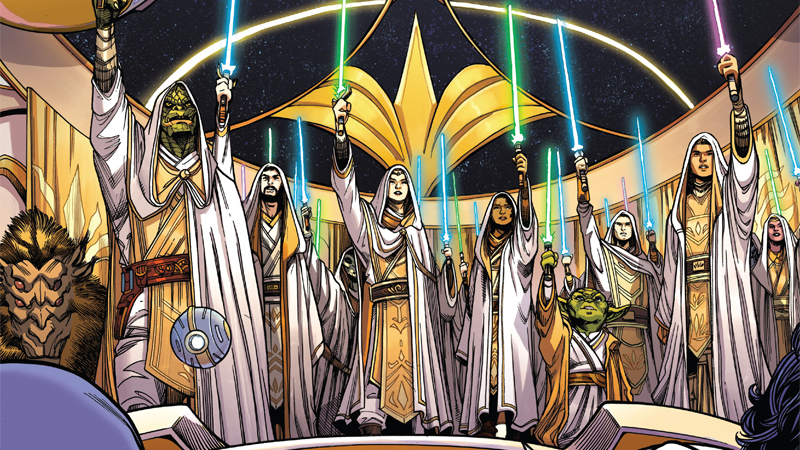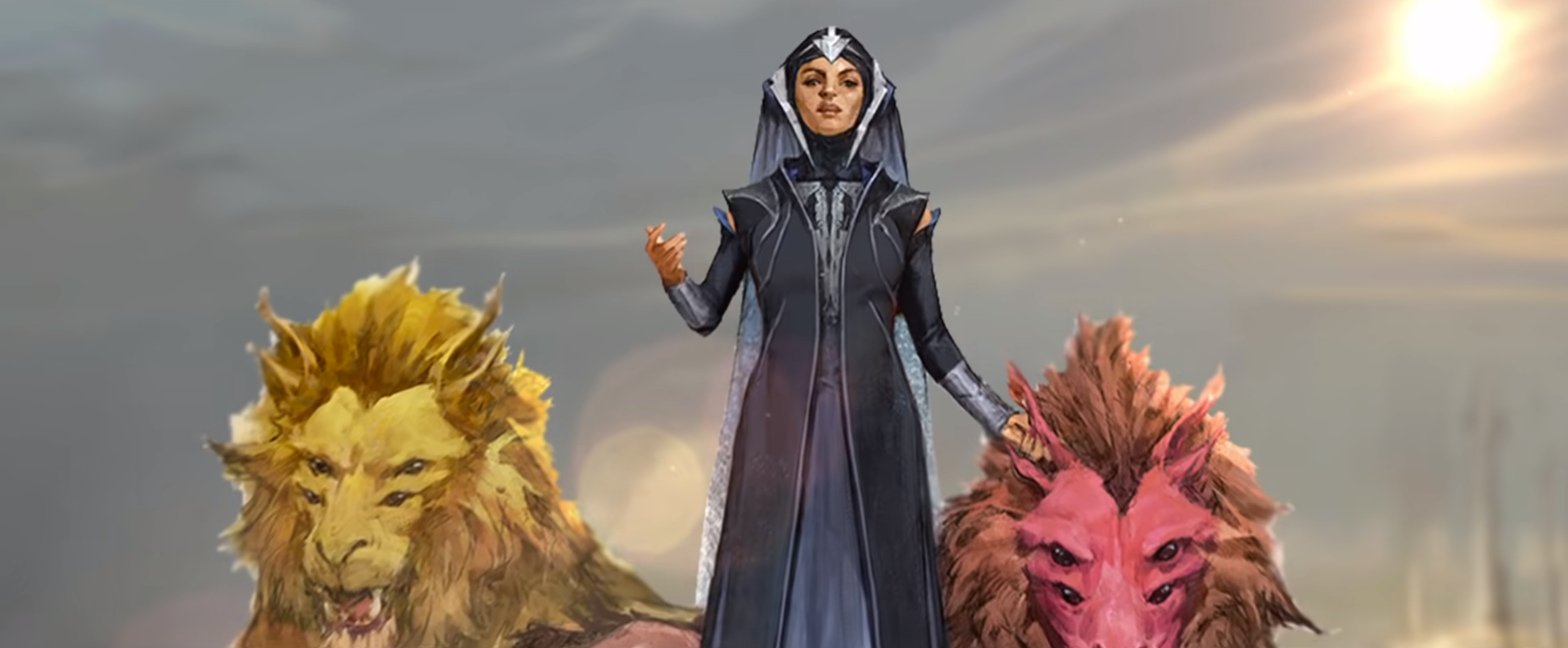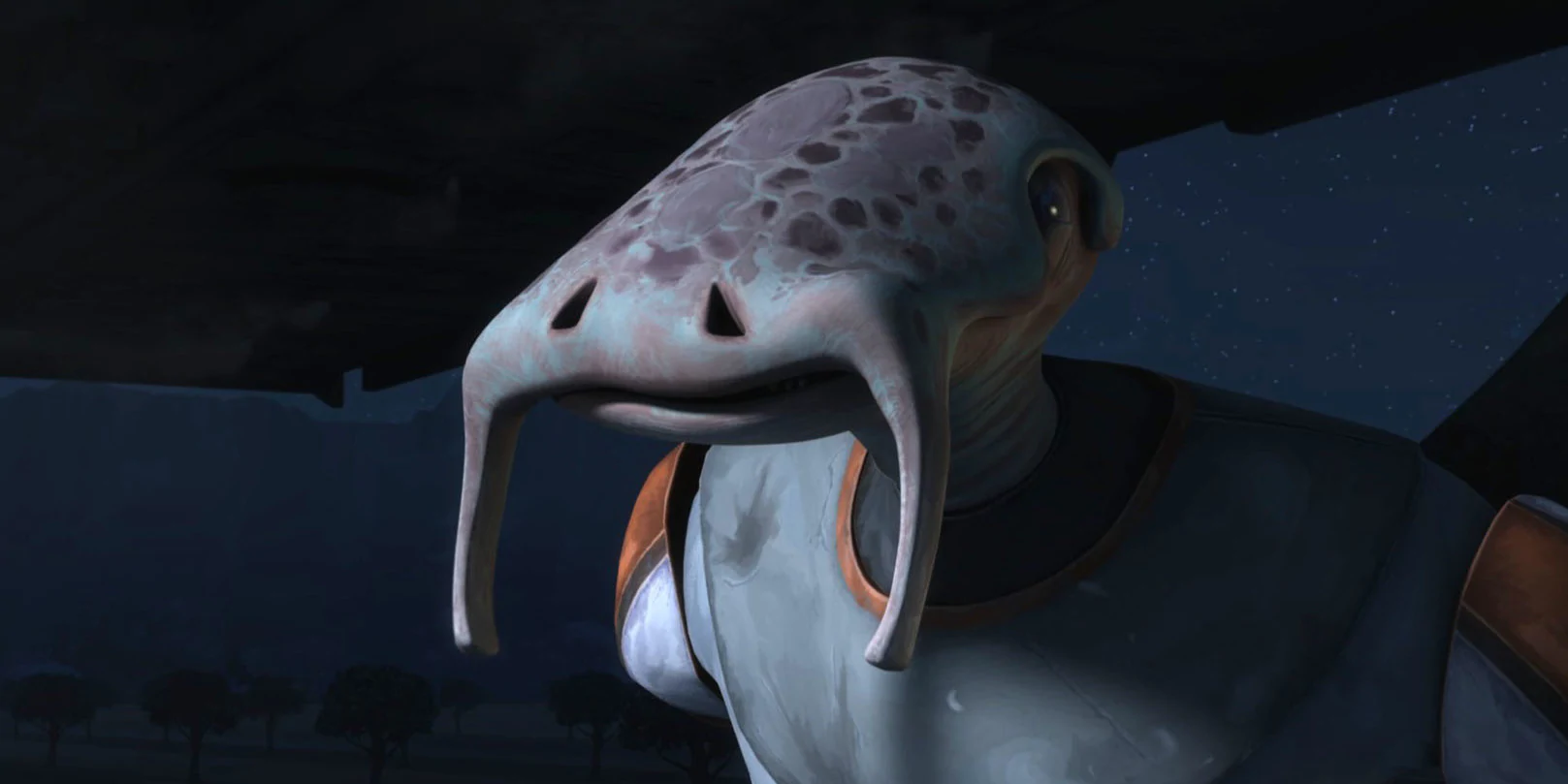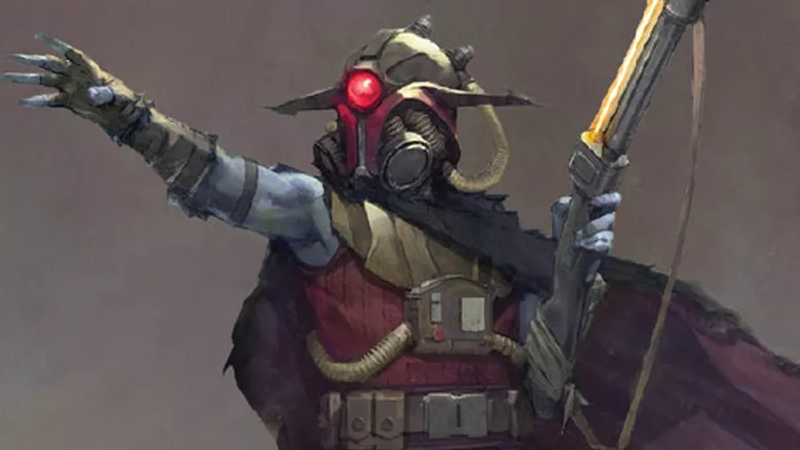The first wave of Star Wars: The High Republic stories is upon us, painting the broad strokes of what we can expect to see in this era, centuries before the Skywalker saga. After checking in with the new books and comics that hit shelves last week, we’re already getting a picture of some intriguing connections — and a taste of what to expect from the Jedi’s heights.

Luminous Beings Are We…
One thing very clear across the first series of High Republic stories — the launch of Marvel’s ongoing comic series, A Test of Courage, and primary adult novel Light of the Jedi — is that the Jedi’s peak here is not necessarily about their power over the Force. In fact, it’s made incredibly clear that even the most luminous of the Jedi we meet across this story still feel like they barely know anything about using the force.
Elzar Mann, one of the supporting Jedi in Light, is seen as something of a provocateur for his approach to experimenting with ways the Force can be used. So much so that his ascension to the rank of Master is being held back by his inability to just stick to the doctrine the Jedi already know. But even though they know relatively little about how to use and manipulate the Force, the Jedi of the High Republic’s apex are represented instead by the diversity of thought around how each of these individual characters interact with and interpret the Force on a personal level.
[referenced id=”1658261″ url=”https://gizmodo.com.au/2020/12/star-wars-the-high-republic-is-as-refreshing-as-it-is-familiar/” thumb=”https://gizmodo.com.au/wp-content/uploads/2020/12/15/h9nimhvhtfhbi1hrltg5-300×169.png” title=”Star Wars: The High Republic Is as Refreshing as It Is Familiar” excerpt=”Adding something truly new to the canon of Star Wars media has to strike a delicate, daunting balance. Anything so vastly removed from what we know about the franchise — particularly the Skywalker saga — has to balance feeling worthy of being called new, while paradoxically still delivering that vague,…”]
There is no one catch-all way these stories describe sensing or manipulating the Force — it’s a choral song, a tapestry, a touch of rain in the clouds. And the biggest moments when a Jedi wields the Force are not necessarily in combative terms. They do engage in conflict across these stories, but the grandest applications of the Force are moments of intense connection, with Jedi coming together to share their abilities in a single, powerful act.
Most of this is through one particular Jedi, Avar Kriss, who has a relatively unique ability akin to Force Meld in the New Jedi Order novels or Bastila Shan’s Battle Meditation in Knights of the Old Republic. In an attempt to stop hyperspace debris from destroying the agricultural worlds of the Hetzal system, Avar reaches out in the Force across the galaxy to connect Jedi in the sole act of pushing an explosive piece of debris out of a collision trajectory with Hetzal’s star. It’s an extreme exertion on both herself and the Jedi who become linked to her — several die in the process, overwhelmed by sheer exertion. But it’s also basically a Force push on a cosmic scale, not some ginormous super attack or epic battle moment, presented as an incredibly desperate act of rescue.

This more relaxed approach to the Jedi of the High Republic is equally reflected in their personalities. While all cut from similar cloths — in that they’re good people trying to do the best they can for those around them — what makes the Jedi in these stories stand out in comparison to ones we saw in the Skywalker Saga is in their warmth and freeness with each other. Keeve Trennis in Marvel’s The High Republic is a teen hothead and isn’t exactly admonished for that as she finds herself on the path to Knighthood. Vernestra Rwoh in A Test of Courage uses a modified lightsaber that can also be used as a lightwhip — technology seen in the Jedi’s past as linked to the old Sith, but she is willing to use and experiment with it to push back against that view of it.
In Light, we meet a whole bunch of Jedi with similarly freewheeling attitudes, but the aforementioned Elzar and Avar once again are interesting in this regard; extremely close friends from a young age, it’s never explicitly acknowledged but heavily implied that they previously had a romantic relationship with one another, displaying a warmth and affection even in the present that would make the Jedi Council of the prequels blush with indignation. And yet, while it’s not entirely presented out in the open, their love for each other — romantically or platonically — is never presented as a taboo. It wasn’t just a more civilized age when it comes to things like lightsaber design or Force use, it seems.
[referenced id=”1659262″ url=”https://gizmodo.com.au/2020/12/the-high-republics-writers-on-why-they-wanted-to-make-star-wars-without-a-war/” thumb=”https://gizmodo.com.au/wp-content/uploads/2020/12/18/r1hvewr0nv3umgblus4q-300×169.png” title=”The High Republic’s Writers on Why They Wanted to Make Star Wars Without a War” excerpt=”Conflict is at the very heart of Star Wars. Light vs. Dark. Good vs. Evil. Empire vs. Rebellion. So many of the stories we have seen woven throughout its world are rooted in the very idea of combat and war. It’s in the name! So in order to do something…”]
The Jedi’s Long History, and Its Dark Future
In tandem with all of that is our own knowledge that this “High” Republic won’t last, an undercurrent that lingers throughout each of these stories in subtle ways, even as conflict between the Republic and the Nihil (more on them later) ramps up. The Jedi in this period feel keenly aware of past failures in their order’s history — there’s plenty of references to not just conflicts like the Sith Wars and battles against the Mandalorians, referencing both the old Knights of the Old Republic mythology and conflicts hinted at in shows like The Clone Wars, Star Wars Rebels, and The Mandalorian, but times when the Jedi Order was not as vast, beloved, or populous as it is at this time.
The history of rise and fall, of purges and expansion, is referenced multiple times, as if the Jedi are almost aware that it will not always be the case that they are the preminent guardians of peace and justice across the galaxy. This is made more fascinating by some Jedi who have passing appearances across this story, given that they will still be around 200 years later by the time of the prequel movies — when the order has grown stagnant and blind to the idea of its impending downfall. It’s not just Yoda, who makes brief appearances here but will go on to have a more prominent role in the IDW young readers comic The High Republic Adventures. The council of this era includes blink-and-you’ll-miss-it luminaries like Yarael Poof and Oppo Rancisis, each are represented as keenly aware of the dark roads the Jedi have gone down before — and know they could again, should they continue to align themselves closer to the Republic’s impending conflicts.

We Are All The Republic
As well as introducing us to this era’s Jedi Knights, Light of the Jedi, A Test of Courage, High Republic #1, and the young reader picture books also have to, in turn, introduce their closest allies within the Republic’s executive offices. Although we meet a few senators and aides, there are also officers within the Republic’s loosely-connected peacekeeping forces. It doesn’t have a standing army or navy, but instead the Republic Defence Coalition, a small peacekeeping organisation that works with the Jedi, themselves drafted into military engagements here alongside Republic officers for the first time in most of its order’s living memory. But the most important Republic figure we’ve met so far is its head of state: Chancellor Lina Soh.
Soh is presented as a unifying figure driven by the connection the Republic has not just between member worlds — regardless of their location — but worlds that could yet be part of the Republic as her expansionist policies continue to push its reach ever further into the Outer Rim. A unifier and idealist, she’s fascinated with what she repeatedly refers to as her Great Works: monuments and tributes to the Republic’s ideals (like the Starlight Beacon station being built on the current edges of Republic space in the Outer Rim that becomes a de facto hub for the Jedi and these stories so far) that she hopes will forever outlast her term as Chancellor.
Soh’s optimism for a Republic that cares for all of its citizens is tempered by a shrewd, firm approach to any potential threat to its growth, whether it’s the hyperspace disaster that becomes known as the Emergences across these early stories, or eventually the Nihil, who Soh essentially declares war on by the end of Light of the Jedi.
That latter event also places her relationship with the Jedi at large in an interesting light — at the current moment, the Republic general relationship with the Jedi Order is amicable, but distant. The Order’s temple is on Corsucant, sure, but they’re not political advisors or really helping to shape policy, they’re an entirely independent branch that just so happens to help the Republic if it suits the Order’s goals. The general populace sees them as great, but strange beings, the subject of romantic holonovels about love and frontier justice rather than the right hands of the Senate as we’d come to know them in the prequel films. Soh’s decision to essentially marshal the Jedi into military action alongside the RDC is a major turning point in the Order’s place within the Republic’s structure, and, well…we kind of already know how it’ll turn out.
[referenced id=”1658953″ url=”https://gizmodo.com.au/2020/12/the-high-republics-writers-on-bringing-new-voices-and-fresh-perspectives-to-the-star-wars-galaxy/” thumb=”https://gizmodo.com.au/wp-content/uploads/2020/12/17/nyaz568amjt3h7oiviv7-300×169.png” title=”The High Republic’s Writers on Bringing New Voices and Fresh Perspectives to the Star Wars Galaxy” excerpt=”The High Republic is one of the biggest gambles the publishing branch of the Star Wars galaxy has taken since Lucasfilm was sold to Disney and its entire canon was rebooted. As Star Wars begins to explore the pathways of streaming and lies waiting at the box office for a…”]
Hyperspace and the Great Disaster
Hyperspace travel and the technology behind it plays a major role in these early stories, which makes sense as they’re all primarily concerned with the outer rim — a region of space that is populated, but not heavily mapped, especially by Republic navigators. Traversing hyperspace in a structured capacity, through discovered and dispersed routes, is still a relatively recent thing by this period of the High Republic. Light of the Jedi introduces us to ancestors of the San Tekka line, a family of navigators and entrepreneurs (a family business currently maintained by husbands Marlowe and Vellis) who have become prominent, lucrative maintainers of maps and charts of safe, secure hyperspace travel in the known galaxy.
All that is thrown into haywire with the Great Disaster — the collision between a Republic colonist ship called the Legacy Run and what is eventually revealed to be a Nihil raider. The Legacy Run’s disintegration mid-jump scatters debris, some containing surviving passengers, across hyperspace, dropping pieces out anywhere along a route at blistering speeds, turning them into devestating meteor strikes that can ravage star systems in a moments notice. It’s a cataclysm that is presented as something unlike anything witnessed in the Republic’s history and creates a crisis that will fundamentally reshape both it and the Jedi Order as they’re roped in to offer relief (and justice for the Disaster’s perpetrators), in part because hyperspace is still such an unknown quantity, much like the Force.
The Republic moves to lock down hyperspace travel to the Outer Rim for the duration, creating a socioeconomic logistical crisis in turn out of the need to divert aid to worlds suddenly cut off from trade routes and transit paths. It makes, for a rare moment in Star Wars, the galaxy seem impossibly larger and more unwieldy than it ever has been, and the physical act of traversing it so much more complex than just slamming down on a hyperdrive throttle and calling it a day.

The Rise of Bacta
Hyperspace technology is not the only recent discovery that these first stages of the High Republic is deeply fascinated with, however. A particularly important development that plays a major role in the Jedi’s relief efforts is that one of the first systems affected by the Great Disaster is Hetzal, an agricultural system whose main resource and export has boomed in necessity because it was found it can be synthesized into the organic components of a new medical device: Bacta.
Star Wars fans have known about the wildly miraculous healing properties of Bacta since Luke was submerged in a tub of it in Empire Strikes Back. It’s been interwoven throughout Star Wars media ever since as the first aid of the galaxy far, far away — as has its much less efficient predecessor Kolto, the naturally occurring healing liquid manufactured by the aquatic Selkath in Knights of the Old Republic, both of which get name-checked in Light of the Jedi.
Its discovery here is once again presented as a gamechanger unlike anything the protagonists of these stories has seen before, and is in part the reason the Jedi race into action to help save the system from total disaster. It’s also just really cool that, even though already familiar to us, one of the biggest “whoa” pieces of technology in these early stories isn’t a super weapon or some kind of capital ship: it’s just…really good medicine. That’s neat!
[referenced id=”1661783″ url=”https://gizmodo.com.au/2021/01/star-wars-the-high-republic-teases-a-long-future-filled-with-new-books-and-comics/” thumb=”https://gizmodo.com.au/wp-content/uploads/2021/01/05/qr8mq3nqd1j00n0suvqw-300×162.jpg” title=”Star Wars: The High Republic Teases a Long Future Filled With New Books and Comics” excerpt=”The Mandalorian may be over for now, but the next chapter in Star Wars begins this week. Star Wars: The High Republic finally debuts tomorrow with the release of several books and comics set generations before the Skywalker Saga. You’ve been hearing about it for a while, and it’s finally…”]
Shadow of the Nihil
Aside from the Great Disaster — which isn’t really an antagonistic “force” — the threat established early on in these new stories, Light of the Jedi and Test of Courage in particular, is the Nihil. A gang of raiders in the outer rim of relatively low standing, they find themselves rocketed onto the intergalactic stage thanks to the machinations of their young new figurehead, Marchion Ro, when he subversively plans the Legacy Run disaster as an intended attempt to ignite hostility between the Republic and the worlds its beginning to encroach on in the Outer Rim.
The Nihil itself is loosely divided into three strata. At the top is the Eye, an inherited title for the figurehead of the Nihil. The Eye distributed general orders and access to resources and technology to the next, most powerful layer of command: three Tempest Runners who each manage their own militias of raiders and ships — frontline pirates divided into the descending ranks of Storm, Cloud, and Strike. The structure was adopted by the arrival of Ro family within the Nihil organisation, when Marchion’s father, the previous Eye, got them access to hyperspace technology even more advanced than the current charts and systems used by the Republic.

Dubbed as “The Paths” and powered by specifically attuned hyperdrive engines, the Eye of the Nihil hands over access to these intricately detailed routes that are otherwise incapable of being accessed by conventional hyperspace engines. Not only do they allow Nihil ships to travel relatively undetected, the paths are intricate enough that, with the right calculations, Nihil ships can perform intensely short point-to-point hyperspace jumps, allowing them to reposition in battle (or, similar but not quite as far as Admiral Holdo’s desperate manoeuvre in The Last Jedi, prepare their ships for ramming actions by jumping within the immediate proximity of an enemy ship).
The paths, and Ro’s access to them, are what ultimately catapult the Nihil’s status from outer rim gangs to an interstellar threat by the time this first wave of High Republic releases comes to an end, setting the stage for a conflict not seen in the Republic’s history for a considerable time.
Our first few forays into the era of Star Wars: The High Republic paint a fascinating picture of what’s to come, not just fleshing out this period of history but providing parallels and contrasts to the systems and organisations we’ve taken for granted in Star Wars’ own, long history. But for all its connections to what we know of Star Wars right now, what makes it stand out (so far, at least) is its willingness to use that familiarity to ask new and exciting questions about the galaxy far, far away.
As The High Republic continues — and the inevitable twilight of its systems draws slowly but surely closer — it’ll be interesting just how much this balance can be maintained as Star Wars’ traditional stories of good versus evil, light and dark, and war and conflict, begin to enter the picture. We’ll be there every step of the way to let you know what’s up!
